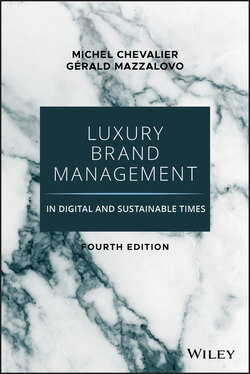Читать книгу Luxury Brand Management in Digital and Sustainable Times - Michel Chevalier - Страница 52
Brand Extension and Legitimacy
ОглавлениеAs we have seen, the process of establishing a brand often starts with a name. But the name can limit the scope of the business to the craft of the founder: Ferragamo and Prada make shoes; Gucci makes handbags; Louis Vuitton makes travel bags; Christofle makes silver-plated tableware, and so on.
To develop a fully fledged business, it becomes necessary to enlarge and diversify the product line to increase the sales volume on which to advertise. If Calvin Klein was extremely well known in the United States, he was relatively unknown in Europe and Asia until his perfume line was advertised heavily and became a success. On the back of this success, he was able to open stores for his fashion lines in Europe and Japan.
This process of line extension—moving away from one product category to another one—is particularly delicate for luxury goods. It took seven years for the first Bulgari watch to be successful. It took approximately the same time for Boucheron watches to start selling. While the psychological distance from jewelry to watches may seem very slight, it still takes a lot of time for the consumer to get used to the shift.
Some extensions have been more rapid and without apparent problems. When Prada went from shoes to handbags and then into the ready-to-wear field for women and men, it worked almost every time. The same thing happened with Gucci in its line extensions.
Other cases have been more delicate. In the 1990s, Christofle decided that tableware was not a fast-growing market. Recalling its origins as silversmiths, it decided to launch a jewelry line, opting for white gold. After the launch of its first collection, it produced a watch, also in white gold. But the company moved too far away from its traditional area of expertise and failed to make sufficient investment in advertising and promotion; the first extension did not work and proved to be a major setback for the brand.The second one is in the process today.
When Chanel decided to extend into jewelry, it was much more careful, launching a single model of watch from free-standing boutiques set up specifically for this purpose in Place Vendôme and Avenue Montaigne in Paris. The watch was a success. The company waited another four or five years before setting up a very large jewelry store in Place Vendôme, the best location for major jewelers in Paris. This, too, was a success.
Baccarat provides another interesting story. It was selling crystal glasses and facing the same problem as Christofle: difficulty in the tableware market. The company decided to concentrate on lamps and candle-holders for the home and to move into crystal jewelry pieces. It invested heavily, gave the best locations in its stores to this product line, and today, diversification products represent the majority of the brand's total sales.
The conditions governing line extensions can be summarized as follows:
Never believe it will be easy.
Make a major investment and a major effort.
Do not start small as a side business.
Do not believe that consumers will be immediately convinced. Give them time.
Emphasize coherence and style.
Find a credible reason why the new product line is appropriate for your brand.
Of course, with time and investment, everything is possible. But a careful review at the outset of the differences and the major issues the new product category will bring to the brand is vital.
